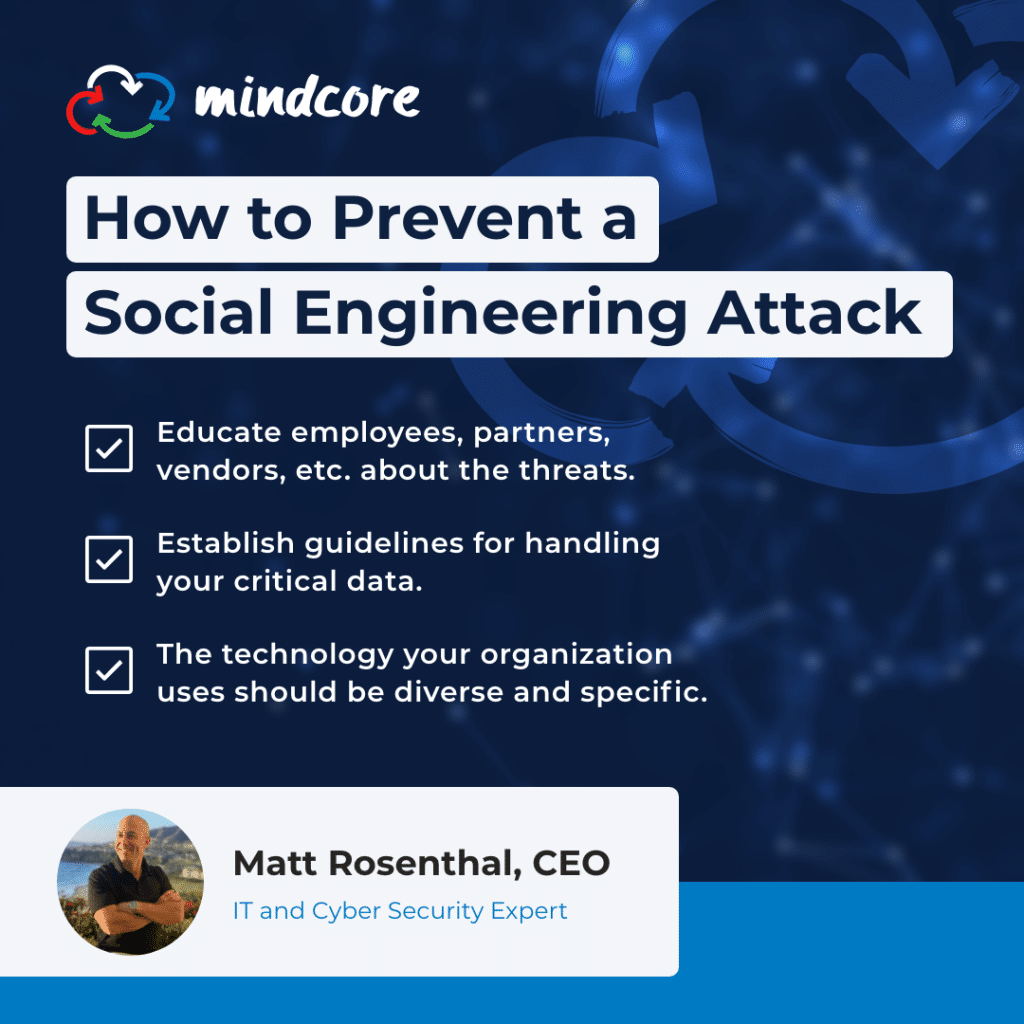
Social engineering attacks use psychological manipulation to trick users into making security mistakes or giving out sensitive information. These malicious activities are becoming more common and increasingly sophisticated, affecting both enterprises and SMBs alike.
Social engineering typically involves email or other communication that invokes urgency, fear, or similar emotions in the victim, leading them to cause potentially harmful acts against their organizations. Preventing social engineering attacks can be very tricky, so companies, employees, and end-users need to understand social engineering efforts and how to prevent these attacks from succeeding. Here’s what you need to know.
The Most Common Social Engineering Attacks
Phishing & Spear Phishing
Some of the most common social engineering attacks are phishing and spear phishing. Phishing emails are sent to a large number of recipients, appearing as an official email with a link that may contain malware when downloaded, stealing personal or company information that may lead to fraud or identity theft.
Spear phishing, however, are carefully designed emails that target a single individual. Cyber attackers target a single individual within a company and create and send a personalized, fake email with a link. This link may contain malware that is inserted into your computer.
Ransomware
Ransomware has seen a dramatic increase in recent years. Attackers send an attachment such as “URGENT ACCOUNT INFO” with a file extension of “PDF.zip” or “PDF.rar,” which slips by the unsuspecting victim and delivers the payload. This attack often encrypts the entire hard disk and requires a payment to unlock.
Wireless Man-in-the-Middle
Man-in-the-middle attacks occur when a third party intercepts the communication between two systems. You can experience this in any sort of online communication, whether it is through email, web browsing, or social media.
With a public WI-FI connection, the attacker can listen to your conversation or inject data into your connection to gain access to the browser or app you’re using to transfer data or even compromise your entire device. Once they gain access to your device, they can cause serious damage, including stealing credentials, installing malware, transferring data files, or even start spying on you.
Vishing
Vishing, or voice phishing, is the use of telephony to conduct phishing attacks. Vishing attacks involve people pretending to be from reputable companies, leaving voice messages, or making calls that are fraudulent to persuade individuals to give them personal information. This information may include financial information, company passwords, and other confidential work information.
Tailgating or Piggybacking
Tailgating, or piggybacking, involves an attacker who aims to gain access without authorization. For example, it can occur when an unauthorized person tags along with an authorized person to gain entry into a company’s restricted area or pass a certain checkpoint. It can either be a physical or electronic attack.
Malicious Websites
Malicious websites are often disguised as corporate or partner sites, prompting visitors to update Java/Adobe or install a specific plug-in. In the case of a drive-by download, the website will attempt to install malware on your computer without asking for permission first. Malicious websites can look legitimate but disrupt computer operation, gather personal information, or gain total access to your machine.
What Companies Should Understand About Social Engineering Attacks
Social engineers will take whatever means necessary to break into a network and steal information. What most organizations need to know is that most successful social engineering attacks occur through email. Emails are used company-wide and can direct a threat to everyone in a small or large organization. It’s one of the most powerful techniques to cause a massive malware infection campaign in a company to target victims effectively and access private information. Individuals and companies need to increase their understanding and awareness of these internet-based attacks to prevent these threats from occurring.
How to Identify And Prevent Social Engineering Attacks
People
While several technical solutions are available to prevent social engineering attacks, the weakest link is often the human. Companies should develop and establish a targeted security awareness program centered on social engineering. Educate employees, partners, vendors, etc. about the threat and their responsibility to prevent it.
Process
Identify your critical data and enlist a third party to perform a risk assessment to determine any potential security gaps. Report on the results of your social engineering tests, both positive and negative, to the executive leadership. Then, once you’ve established guidelines for handling your critical data, perform random and scheduled tests against all employees using social engineering techniques.
Technology
The technology your organization uses is diverse and specific to the data you need to protect from social engineering attacks. It can involve the following technology programs or projects, but is not limited to these:
- Identity and access management
- Security incident and event management system
- Non-signature based malware technology
- Proxy blocking both white and black listing
- Inbound and outbound communication monitoring
Prevent Social Engineering Attacks with Mindcore
Mindcore provides companies in a wide range of industries with customized cyber security solutions to prevent common cyberattacks, including social engineering attacks. Our team will work with you to understand your organization’s current IT infrastructure and provide thoughtful recommendations to improve your network security. Please contact us today to learn more about our services or to schedule a consultation.

